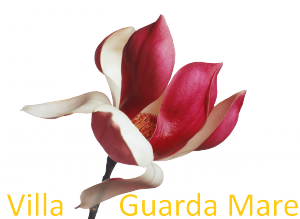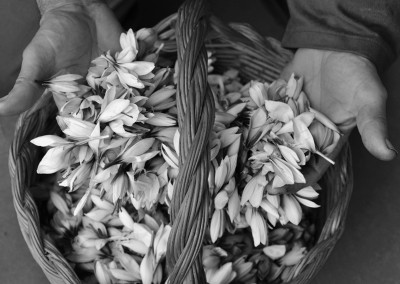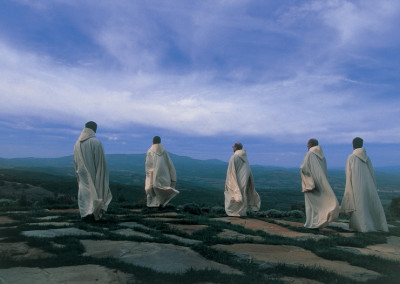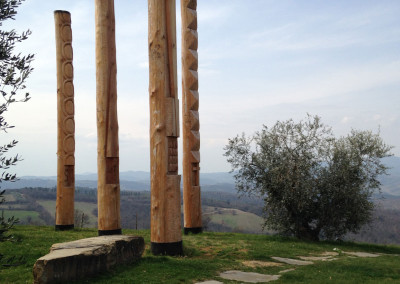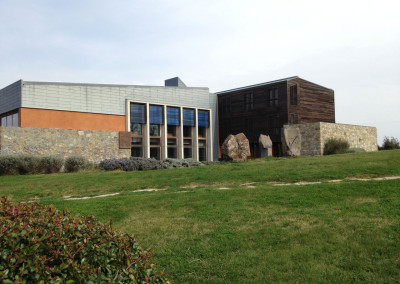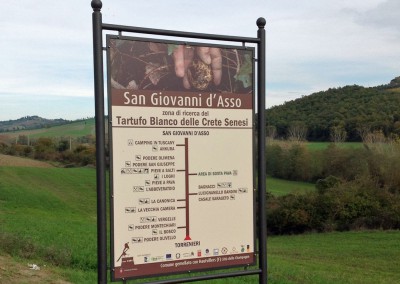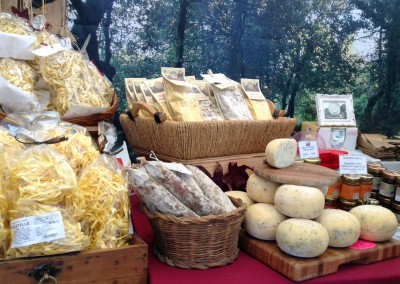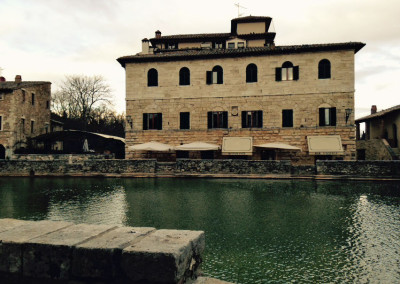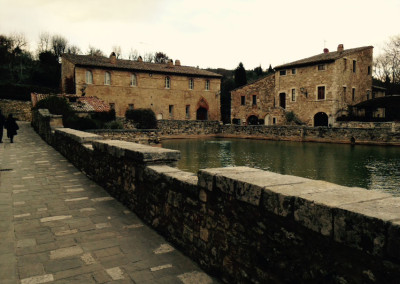The Southeast – Saffron, Wine and natural SPAs
- Monastero di Siloe
- Montecucco
- Brunello
- Castello Banfi
- Montalcino
- Bagno Vignoni
- San Giovanni dʼAsso (nur zur Trüffelzeit)
- Pienza
- Petrioli SPA
After breakfast we start to Monastero di Siloe (ca. 40 km). After about 45 minutes we reach the Benedictine monastery, where monks among other things grow and sell valuable organic saffron. You can also get honey, crostini spreads, organic pasta, etc. A place of tranquility with breathtaking panoramic views. Just dare and go inside. On the way to Cinigiano, visit the medieval village of Castel Porrona. The Cinigiano’s Palazzo Bruchi houses the Strada del Vino Montecucco and the Sapori d’Amiata information center. We are now in the wine-growing region of Montecucco. The “Strada del Vino Montecucco e dei Sapori d’Amiata” wine route has been established with the aim of marketing the typical products of this area. An area that has a variety of producers in a varied landscape, in a harmonious interplay of flavors, fragrances, beautiful views and art treasures. The wine is very similar to the neighboring area Montalcino, but cheaper and very good on selected wineries. Right next door to the Benedictine monastery there is a very good organic wine. The winery Salustri invites to a wine tasting. We recommend a reservation. They also produce salami and bacon of very high quality from their own breeding of a healthy pig breed. Then we drive to the Brunello wine region, visit the beautiful winery Castello Banfi and the town of Montalcino, we take either in the tavern at the winery Banfi or in the fortress of Montalcino our lunch to match the wonderful wines of the region. Then it goes on to the thermal bath Bagno Vignoni. Depending on personal scheduling, weather and interests we dedicate ourselves to the Etruscan Spa or relax in one of the spas. Truffle time then it goes to San Giovanni d’Asso. Also, a trip to Seggiano, where olives of the variety “Olivastra seggianese” grow, from which a particularly precious oil is obtained, can be worthwhile. For here, the artist Daniel Spoerri has created his sculpture park Giardino d’Arte, in which the works of internationally known contemporary artists can be seen. Then to Pienza (World Heritage Site), the ideal city with the best selection of Pecorino cheese (to taste and buy anywhere in the city). Sardinian immigrants brought the cheese to Tuscany, where it was then enriched with local cheese traditions. After a detour at the Therme Petriolo, it’s back to Roccatederighi in the evening. Optionally you can, if the weather does not play along, we recommend the installation of a spa stay. This should be done either in Bagno Vignoni (recommendation Adler Therme – reservation necessary) or in the Petriolo SPA (registration required). We end our evening today at Da Nada, where we can order a bottle of Brunello or Montecucco with a good typical Maremma meal. A bottle of Salustri Santa Marta would be our recommendation.
The Monte Amiata and the Maremma give us on this trip very different, delicate and strong flavors.
Typical Products – The Amiata area and around Montecucco produce traditional agricultural products of exceptional quality: one of the most important is DOC Montecucco quality wine, but no less important is the quality extra virgin olive oil produced at the Strada del Vino Montecucco e Sapori d’Amiata from Seggiano, which received the quality mark DOP. Other traditional products are the chestnut of the Monte Amiata IGP, the Pecorino Toscano DOP and the meat of the Young Cattle IGP; Also worth mentioning: honey, truffles, mushrooms, saffron from Maremma, salted pastries from Roccalbegna, sausages and wild boar salami.
A production of high-quality food that can give a boost to the local economy.
Montecucco is produced on the territory of the Maremma formed by the municipalities of Cinigiano, Civitella Paganico, Castel of the Plan, Campagnatico, Seggiano and Roccalbegna.
The typologies of Montecucco published are: White, Red, Red Riserva, Sangiovese, Sangiovese Riserva, Vermentino.
Montecucco white
Mind. 60% Sangiovese with other white grape vines. The color is a straw-yellow, the smell is fresh and fruity, the lively dry taste fruity. Alcohol at least 11.5%.
Montecucco red
Mind. 60% Sangiovese with other red vines. The color is a red intense ruby; the smell is venous and wide; the taste is harmonious, tanin conscious and really dry. Alcohol at least 12%.
Montecucco Riserva
It has a red color that tends to garnet like intense ruby; the smell is venous, broad, elegant and characteristic; the taste is full, an elegant heat with the possible woodiness, dry. Alcohol at least 12.5%.
Montecucco Sangiovese
Mind. 85% Sangiovese with other red vines. The color is a red intense ruby; the smell is venous, fruity and characteristic; the taste is harmonious, tanin conscious and dry. Alcohol at least 12%
Montecucco Sangiovese Riserva
It has a red color that tends to garnet like intense ruby; the smell is venous, broad, elegant and characteristic; the taste is full, an elegant heat with the possible woodiness, dry. Alcohol at least 12.5%.
Montecucco Vermentino
Mind. 85% Vermentino with other white grapevines. The color is a straw-colored yellow; the smell is fine, fresh and characteristic; The taste is dry, soft and tasty. Alcohol at least 11.5%.
In the season it is worthwhile to visit the place San Giovanni d’Asso. There you can get delicious local truffles and matching dishes.
FESTA DEL TARTUFO MARZUOLO San Giovanni d’Asso First weekend in March
His white, smooth, but irregular skin gives him a great resemblance to the white truffle. His season, however, is from late December to April. Tastes like a very mature summer truffle, but it is a little less intense. Mostly much smaller. Average 1-3 cm diameter. May be light or dark in color depending on the soil properties. Its structure is a bit softer than that of the summer truffle, but the marbling is more pronounced. Among the not so expensive truffle types, the March truffle is certainly the most characterful. The march truffle is consumed raw, because boiled evaporates even the last bit of truffle fragrance. He occurs in Tuscany, especially in Maremma. These truffles are suitable for all classic truffle dishes and are still best served simply with browned butter and shaved over the finished noodles. Otherwise, the same applies as for all truffles: Only brush off, never wash with water and keep slightly chilled in a closed glass jar, if possible not too long. If you take a look at the truffle recipes for Bianchetti truffles, preparations with quail egg and spinach seem to go very well with this special garlic-flavored truffle variety.
The precious white truffles are also available in San Giovanni.
MOSTRA MERCATO DEL TARTUFO BIANCO DELLE CRETE SENESI San Giovanni d’Asso
Second and third weekend in November
